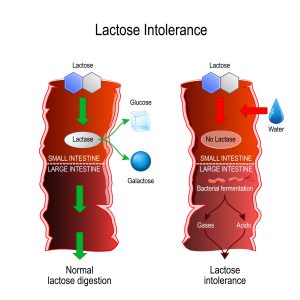WORDS LIM TECK CHOON
 FEATURED EXPERT FEATURED EXPERTDR ONG SIK YONG Consultant Paediatric Gastroenterologist and Hepatologist Sunway Medical Centre |
According to Dr Ong Sik Yong, lactose intolerance is a common gastrointestinal condition caused by the inability to digest and absorb dietary lactose.
Lactose intolerance is the result of your small intestine not producing enough of an enzyme called lactase. Lactase helps to break down lactose or milk sugars into simple sugars for absorption by your body.
BLAME IT ON DECLINING LEVELS OF LACTASE
Dr Ong shares that newborns can digest about 1 litre of breast milk every day.
However, the enzyme lactase, which digests lactose, usually declines in levels once the child stops breastfeeding, a circumstance known as lactase non-persistence.
“Approximately 70% of the world population are affected by lactase non-persistence, which causes the condition called primary lactose intolerance,” Dr Ong reveals.
He adds that generally a child shows symptoms of primary lactose intolerance after they turn 5. However, some children may exhibit symptoms as early as 2 years old.
CAN ALSO BE DUE TO OTHER GUT ISSUES
In young children, lactose intolerance may also be caused by underlying gut issues such as:
- Gut infection.
- Cow’s milk allergy.
- Celiac disease.
- Inflammatory bowel disease.
Dr Ong further shares that sometimes a child may temporarily lose the ability to digest lactose during an episode of acute gastroenteritis. Once the child recovers, however, they can continue to consume milk without further issues.
SYMPTOMS OF LACTOSE INTOLERANCE
“Usually, symptoms begin about 30 minutes to two hours after consumption,” says Dr Ong.
He adds that the common symptoms are:
- Abdominal discomfort.
- Bloating.
- Farting.
- Diarrhoea.
- Perianal skin irritations with raw lesions surrounding the anus, due to low faecal pH in the child’s stools.
MANAGING THE DIET OF A LACTOSE INTOLERANT CHILD
Dr Ong advises parents to feed dairy products with naturally lower lactose content to children that show signs of lactose intolerance.
“After a period of limiting food with lactose, the child can consume back small amounts of foods and drinks containing lactose,” he adds.
The child’s symptoms should be observed throughout this trial period and over time, the parents or even the child would be able to tell how much of lactose the child can take.
“Besides that, parents can also consider using lactase enzyme, which can be taken by the child prior to consumption of dairy products to reduce unwanted consequences from consuming lactose,” advises Dr Ong.
NUTRITIONAL CONSIDERATION FOR THE LACTOSE-INTOLERANT CHILD
Milk and other various dairy products are a major source of calcium and vitamin D.
“Hence, it is important to make sure children who has limited dairy product intake to have other non-dairy food which are rich in these nutrients, like fish with soft edible bones, such as salmon and sardines, as well as green leafy vegetables. They may also require calcium or vitamin D supplement for their growing bones,” Dr Ong says.



